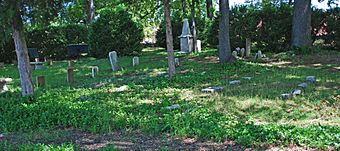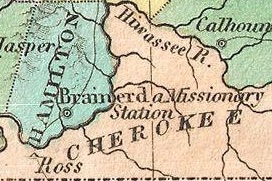Brainerd Mission facts for kids
Quick facts for kids |
|
|
Brainerd Mission Cemetery
|
|

Brainerd Mission Cemetery
|
|
| Lua error in Module:Location_map at line 420: attempt to index field 'wikibase' (a nil value). | |
| Location | 5700 Eastgate Loop, Chattanooga, Tennessee |
|---|---|
| Area | 1 acre (0.40 ha) |
| Built | 1817 |
| Architect | William Crutchfield |
| NRHP reference No. | 79002435 |
| Added to NRHP | December 6, 1979 |

The Brainerd Mission was a special school and community for the Cherokee people. It was run by Christian missionaries in what is now Chattanooga, Tennessee. Today, only the Brainerd Mission Cemetery is left. This cemetery is so important that it's listed on the National Register of Historic Places.
Contents
History of the Mission
How Brainerd Mission Started
The Brainerd Mission began in 1817. It was started by a man named Cyrus Kingsbury. He worked for a group called the American Board of Commissioners for Foreign Missions (ABCFM). This group helped spread Christian teachings.
The mission was built on land near South Chickamauga Creek. This area is now part of Chattanooga, Tennessee. The land used to belong to John McDonald. He was a Scots trader and the grandfather of John Ross. John Ross later became a very important chief of the Cherokee Nation.
At first, the mission was called Chickamauga Mission. A few months later, it was renamed Brainerd Mission. This was to honor David Brainerd. He was an early missionary who worked with Native American people in New England.
Building the Mission Community
When the missionaries got the land, there wasn't much there. There was an old gristmill and a few other buildings. But soon, the missionaries and local Cherokee people worked together. They built many new things.
They added separate schoolhouses for boys and girls. They also built homes, a cemetery, and a sawmill. There was a blacksmith shop, a wash house, and a meat house (like a smokehouse). They also built a corn house and stables for animals. The missionaries even had their own home. By the end of the first year, they had also cleared and fenced about 40 acres of land. This land became a farm to help feed everyone.
What Students Learned
The main goal of the mission was to educate Cherokee children. They wanted to teach them Christian values too. Students learned to read and write in English. They also learned to read the Bible in English.
The mission also taught important life skills. Girls learned how to spin thread, knit, and sew clothes. Boys learned about animal husbandry (caring for animals). They also learned farming and mechanical skills.
After about a year, Cyrus Kingsbury left Brainerd Mission. He went to Mississippi to work with the Choctaw Nation. He stayed there for the rest of his career.
Important Visitors and Missionaries
Many important missionaries worked at Brainerd Mission over the years. Some of them were Samuel Worcester, Ainsworth Blunt, and Cephas Washburn.
In May 1819, something very special happened. President James Monroe visited Brainerd Mission. General Edmund P. Gaines came with him. This was the first time a U.S. president visited the Hamilton County area. President Monroe was impressed and gave $1,000 to help the mission.
The Mission's Closure
The Brainerd Mission officially closed on October 2, 1838. This happened because of the Cherokee removal. This was a sad time when the Cherokee people were forced to move from their homes to Indian Territory.
Over 21 years, more than 300 Cherokee boys and girls attended Brainerd Mission. The mission was somewhat successful in its goals. Many students learned to speak and read English well. However, fewer Cherokee people joined the church.
Today, the cemetery is the only part of the mission that remains. The land where the mission once stood is now a shopping center. The cemetery is one of the oldest in Hamilton County. It has about 60 graves, mostly of missionary workers. The Daughters of the American Revolution group has worked hard to protect this site. They still own and take care of the cemetery today.
Notable Students
A few students who attended Brainerd Mission became well-known later in life. Here are some of them:
- Elias Boudinot: He started and edited the Cherokee Phoenix. This was the very first newspaper for the Cherokee people. Boudinot also signed an important treaty in 1835 called the New Echota treaty.
- John Ridge: He was the son of Major Ridge and a cousin of Elias Boudinot. Both John Ridge and Major Ridge strongly supported the 1835 New Echota treaty.
- David Brown (1806-1829): He was a Cherokee clergyman. He translated the New Testament from English into the Cherokee language. He used the Sequoyah syllabary for this work.

